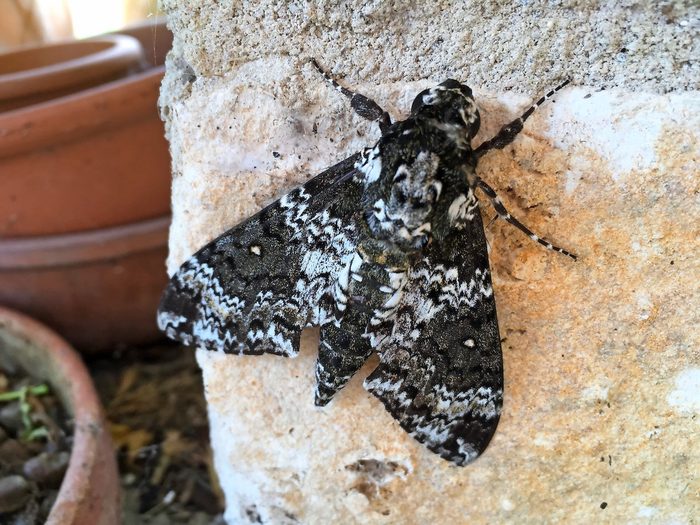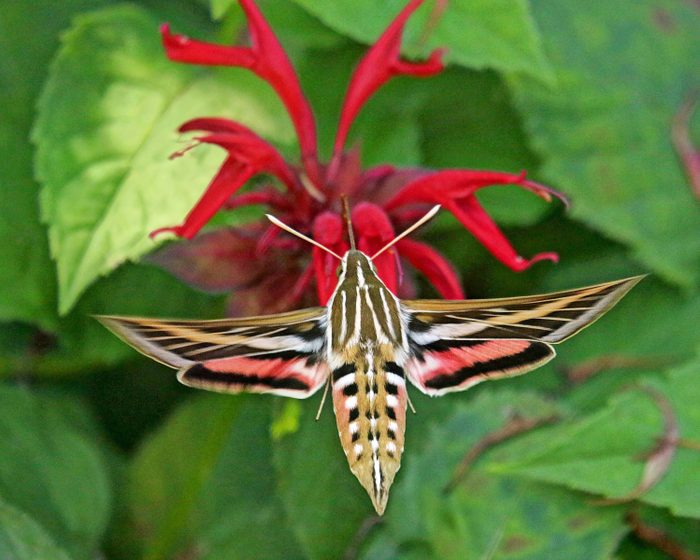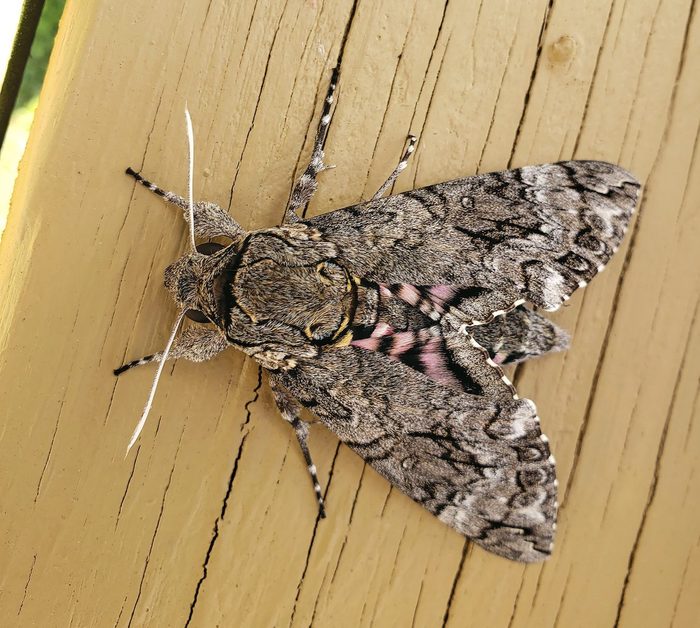Perhaps no bird native to North America is more maligned than the brown-headed cowbird. This smallish blackbird lays its eggs in the nests of host species, letting unsuspecting parents raise its young—a breeding strategy known as brood parasitism.
Meet five types of blackbirds you should know.
On This Page
Brown-Headed Cowbirds Take Over Nests
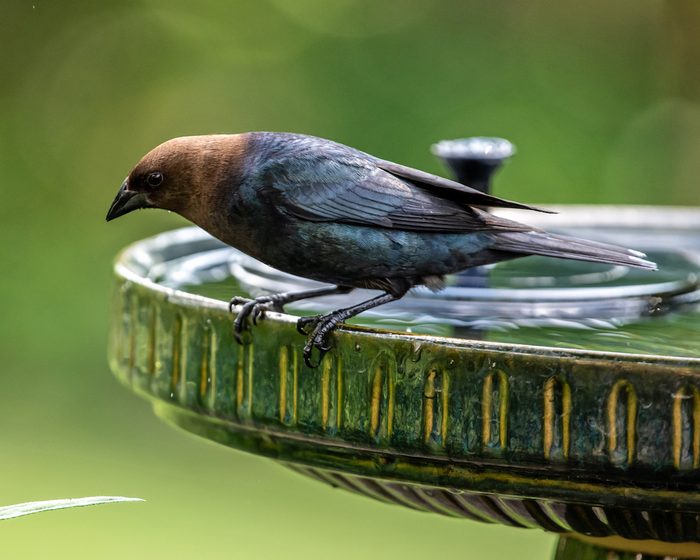
The brown-headed cowbird is the most common brood parasite in North America. Both shiny and bronzed cowbirds, native to the American tropics and extending into some southern states, are also brood parasites.
Female brown-headed cowbirds parasitize more than 200 bird species, including the widespread northern cardinal; grassland birds such as meadowlarks, grasshopper sparrows and dickcissels; and the endangered Kirtland’s warbler. As a native species, cowbirds are protected under federal law, so it’s illegal for humans to remove their eggs from a nest.
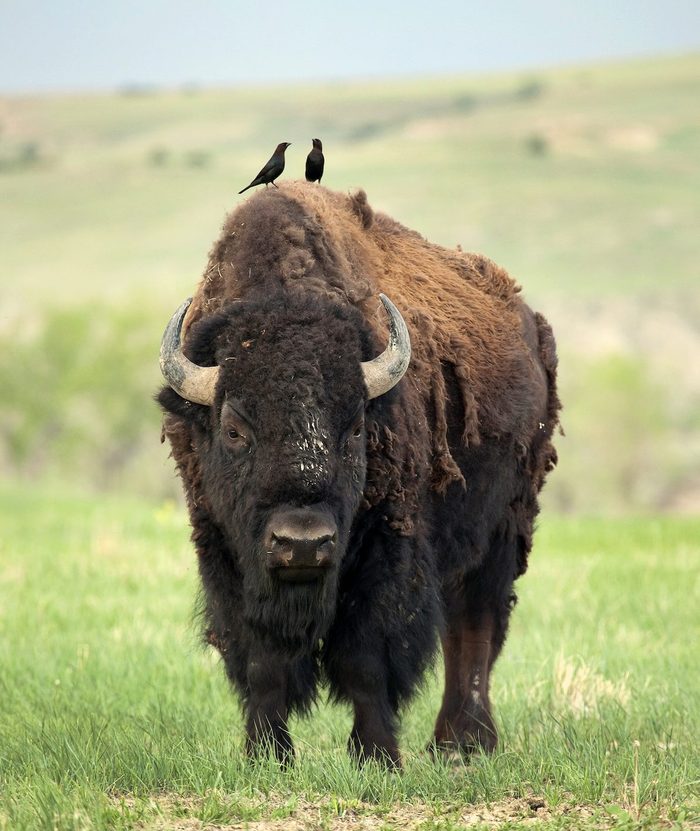
A cowbird looks for a nest containing freshly laid eggs so their own eggs will have enough time to develop, which takes about 11 days. The female cowbird may poke holes in the host’s eggs to judge the stage of development. If it’s fresh, the cowbird may toss it from the nest and replace it with its own egg. If the egg is too developed, the cowbird sometimes destroys the entire clutch in what biologists call farming.
“It forces the host mother to make a new nest that maybe the cowbird can parasitize in her next nesting attempts,” says Sarah K. Winnicki, a PhD candidate in the ecology, evolution and conservation biology program at the University of Illinois Urbana-Champaign.
Learn how to identify a red-winged blackbird and European starling.
Cowbirds Lay Dozens of Eggs Each Breeding Season
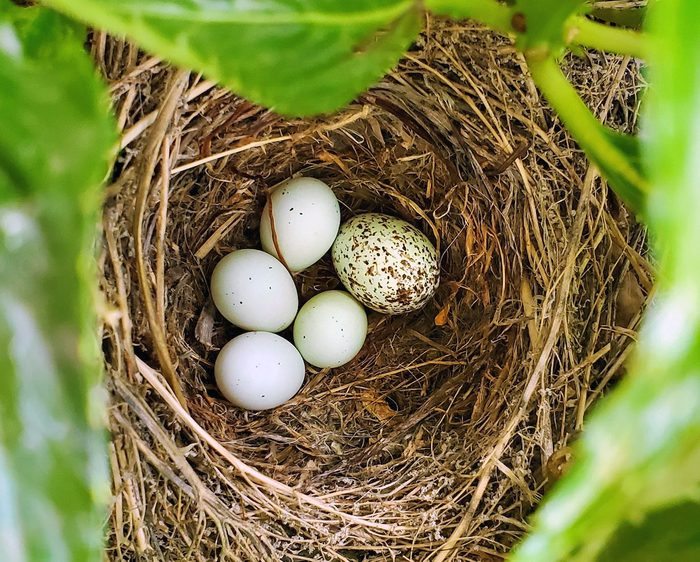
Cowbirds may lay 50 or more eggs in a breeding season. To contrast, a bird such as an American robin lays three to four eggs twice a season. Instead of investing their energy into building nests and feeding young, cowbirds focus on ingesting enough calcium to produce eggs, finding host nests and checking in on their young once they’ve hatched, according to Sarah.
“They’re investing in offspring at a different point in development than other birds,” Sarah says. Because host parents must feed these fast-growing cowbirds that are often larger than their own nestlings, “It’s energetically costly for these parents, keeping them from future reproductive attempts,” Sarah says.
This is how to get rid of blackbirds and grackles at your feeders.
Cowbirds Are Occasionally Outsmarted
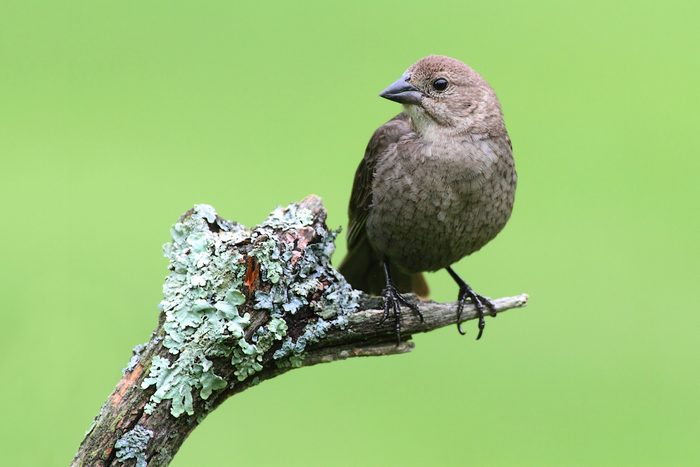
But some host birds have wised up regarding cowbirds. Brown-headed cowbird eggs are white to grayish white with brown or gray spots or streaks. This sets them apart from most host’s eggs, including American robins’ eggs, which are larger and blue-green. Robins almost always eject cowbird eggs from their nests.
And yellow warblers use a seet warning call. “When they hear it, they rush to their nest and sit on it to prevent a cowbird from laying an egg there,” says Sarah, who notes that when a cowbird successfully lays an egg in a yellow warbler nest, the warbler can prevent it from being incubated by building a new nest bottom over the egg.
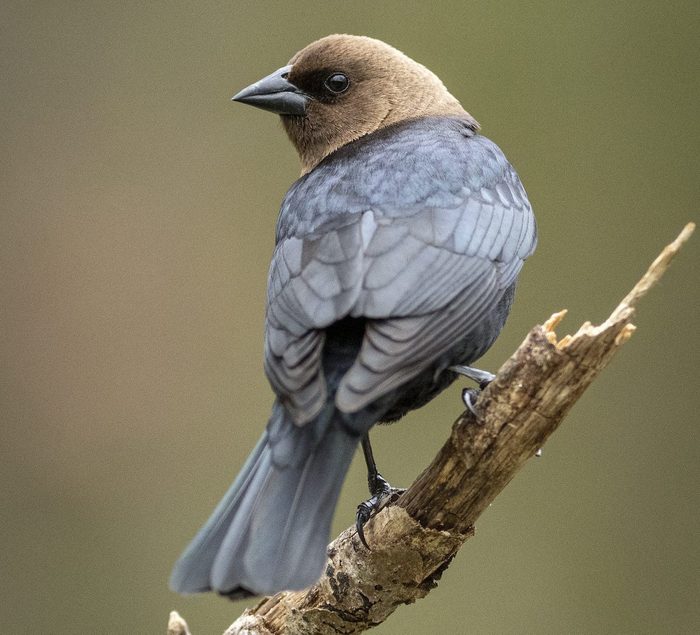
In response, cowbirds will check on nests where they’ve left eggs. If their eggs or hatchlings have been rejected by the foster parent, the cowbird may destroy its nest. “It ensures the host doesn’t pass that behavioral innovation to its offspring,” Sarah says.
Learn how to identify bird eggs by color and size.
Do Baby Cowbirds Reunite With Their Parents?
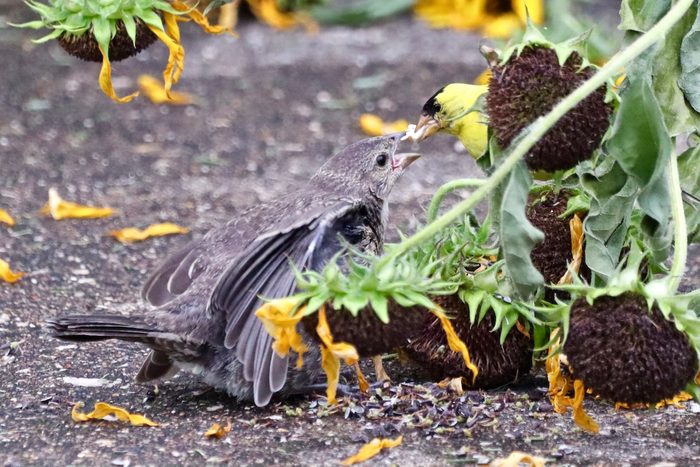
Recent research has found that cowbird nestlings may recognize a female cowbird call. Cowbird young that are at least 12 days old may leave their host nest at night. Sarah says, “They’ll sneak out like teenagers, then come back to the nest to get food in the morning. It could be that they’re meeting other cowbirds in the middle of the night.”
Next, get to know the house sparrow: another disliked backyard bird.
About The Expert
Sarah K. Winnicki is an avian biologist and PhD candidate at the University of Illinois Urbana-Champaign. Sarah’s research focuses on growth rates of songbirds like American robins, and their past research has focused on environmental impacts on growth rates of songbirds in the grasslands.
Sources
- Cornell Lab of Ornithology’s NestWatch, “Brown-Headed Cowbirds”
- Southern Wisconsin Bird Alliance, “Into the Nest: Cowbirds, Everybody’s Favorite Villain”
- The New York Times, “How an Eight-Sided ‘Egg’ Ended Up in a Robin’s Nest”
- National Audubon Society, “How Does a Cowbird Learn to Be a Cowbird?”
Why Trust Us?
For nearly 30 years, Birds & Blooms, a Trusted Media Brand, has been inspiring readers to have a lifelong love of birding, gardening and nature. We are the #1 bird and garden magazine in North America and a trusted online resource for over 15 million outdoor enthusiasts annually. Our library of thousands of informative articles and how-tos has been written by trusted journalists and fact-checked by bird and garden experts for accuracy. In addition to our staff of experienced gardeners and bird-watchers, we hire individuals who have years of education and hands-on experience with birding, bird feeding, gardening, butterflies, bugs and more. Learn more about Birds & Blooms, our field editor program, and our submission guidelines.
On This Page
Which Red Tanager Are You Seeing?
When you’re out birding and you see a flash of red, your first assumption might be that your mystery red bird is a northern cardinal. However, if you know you haven’t spotted a cardinal, the ID’s can get a bit trickier—especially when it comes to two similar-looking tanagers. Here’s how to tell the difference between a summer tanager vs a scarlet tanager.
Scarlet Tanager Identification Tips
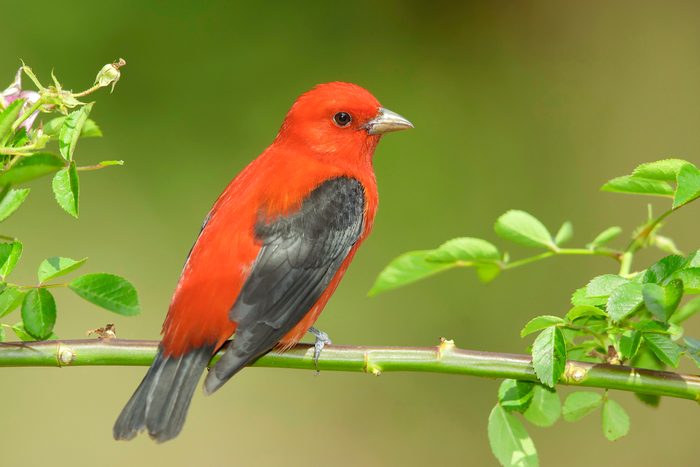
The bold and brilliantly colored scarlet tanager is widespread in the eastern U.S. and southeastern Canada in summer. Adult males are red with solid black wings and tails. These birds are red in spring and summer, molting to olive tones after breeding season. Female scarlet tanagers are olive-yellow all over with grayish wings and tails.
Not typical feeder birds (although they’ll sometimes stop by feeders for oranges), scarlet tanagers mostly eat insects. They’ll also dine on wild fruits and berries. To identify a scarlet tanager by ear, listen for a hoarse, whistled song with phrases in a rapid pattern. Sometimes, the bird’s song is described as an American robin with a sore throat. Its call is a chik-burr.
Learn all about the five tanager species found in North America.
Summer Tanager Identification Tips
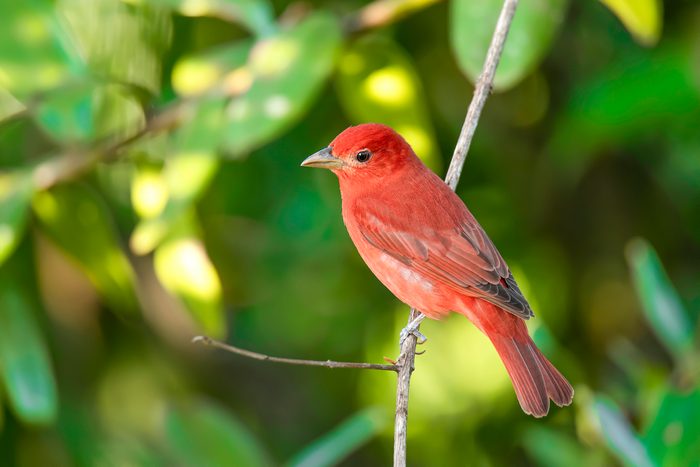
Birders spot summer tanagers in the southeastern U.S. and all through the South into California in summer. Adult males are solid red all over, lacking the scarlet tanager’s black wings. In another key difference between summer and scarlet tanagers, summer tanagers keep that coloring year-round. They’re the only all-red birds that are widespread in North America.
Female summer tanagers are yellow all over with a pink or pale-colored bill.
Similarly to scarlet tanagers, summer tanagers eat mostly insects. They’ll dine on fruits and berries occasionally, but they’re especially known for eating bees and wasps.
To identify a summer tanager by ear, listen for a low, lazy and robinlike song. Its call note is a snappy pick-i-tuck.
Now that you know the difference between a summer tanager vs a scarlet tanager, learn how to identify the sunset colored western tanager.
Sources
Why Trust Us?
For nearly 30 years, Birds & Blooms, a Trusted Media Brand, has been inspiring readers to have a lifelong love of birding, gardening and nature. We are the #1 bird and garden magazine in North America and a trusted online resource for over 15 million outdoor enthusiasts annually. Our library of thousands of informative articles and how-tos has been written by trusted journalists and fact-checked by bird and garden experts for accuracy. In addition to our staff of experienced gardeners and bird-watchers, we hire individuals who have years of education and hands-on experience with birding, bird feeding, gardening, butterflies, bugs and more. Learn more about Birds & Blooms, our field editor program, and our submission guidelines.
On This Page
What Do Male and Female Western Bluebirds Look Like?
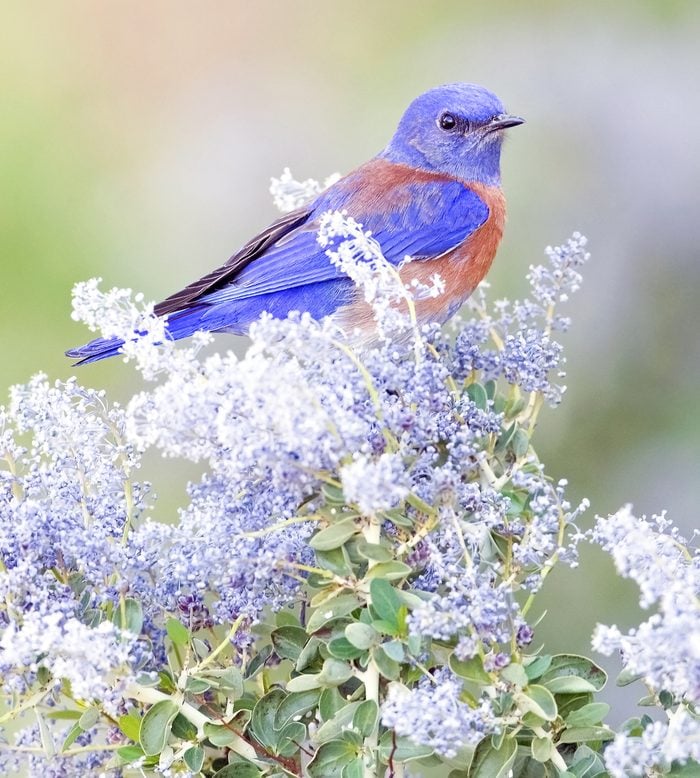
Nothing brightens a backyard quite like a western bluebird. “The blue feathers of a western bluebird sparkle,” says Joyce Volmut, coordinator for Olympic Peninsula Audubon’s western bluebird survey. “They have a real personality. They are comfortable around people, and their color is absolutely fantastic.”
The western bluebird is one of three bluebird species found in North America. True to the name, western bluebirds are West Coast birds that also appear in regions across the West and down south into Mexico.
Male mountain bluebirds are predominantly blue, but male eastern and western bluebirds are more difficult to tell apart because they both have blue and orange plumage. It’s a male western bluebird if it has a blue belly, throat and face.
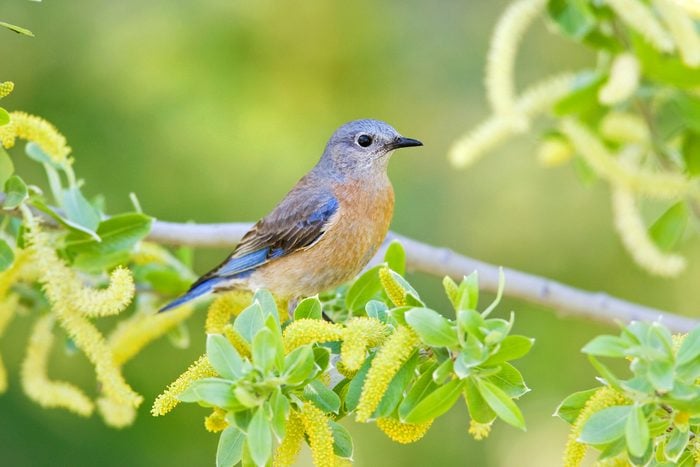
Female western bluebirds lack the bold coloring of males, but look for their blue-tinted wings and tails, and faint orange shading on the breast.
Marvel at these gorgeous pictures of bluebirds — then say “awwwwww!” at these adorable baby bluebirds.
What Does a Western Bluebird Eat?
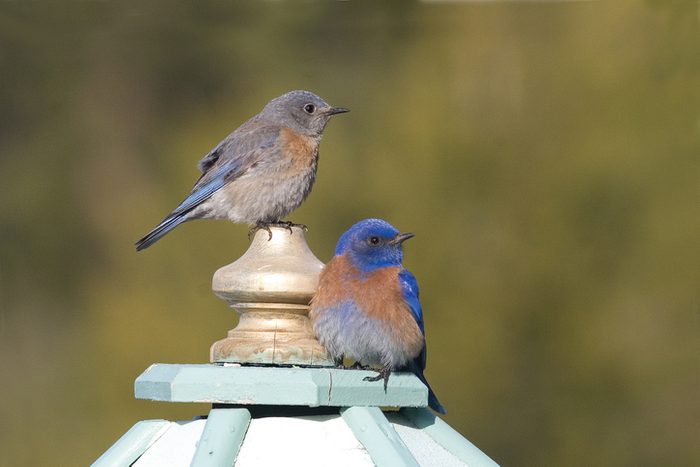
Though western bluebirds eat many berries during the winter, they are primarily insectivores. Their young feed exclusively on bugs. “They’re entertaining to watch, catching insects on the fly,” Joyce says. “Putting out mealworms is a great way to attract them. Likewise, avoid insecticides or pesticides.”
A western bluebird barely tips the scale at just one ounce. To keep their slim figures, they eat about 15 calories a day, or 23 if they are caring for a brood.
With some mealworms or even bluebird feeders, these birds can add bright blue joy to your yard while providing hours of entertainment.
Get more tips on how to attract bluebirds.
Nesting Habits
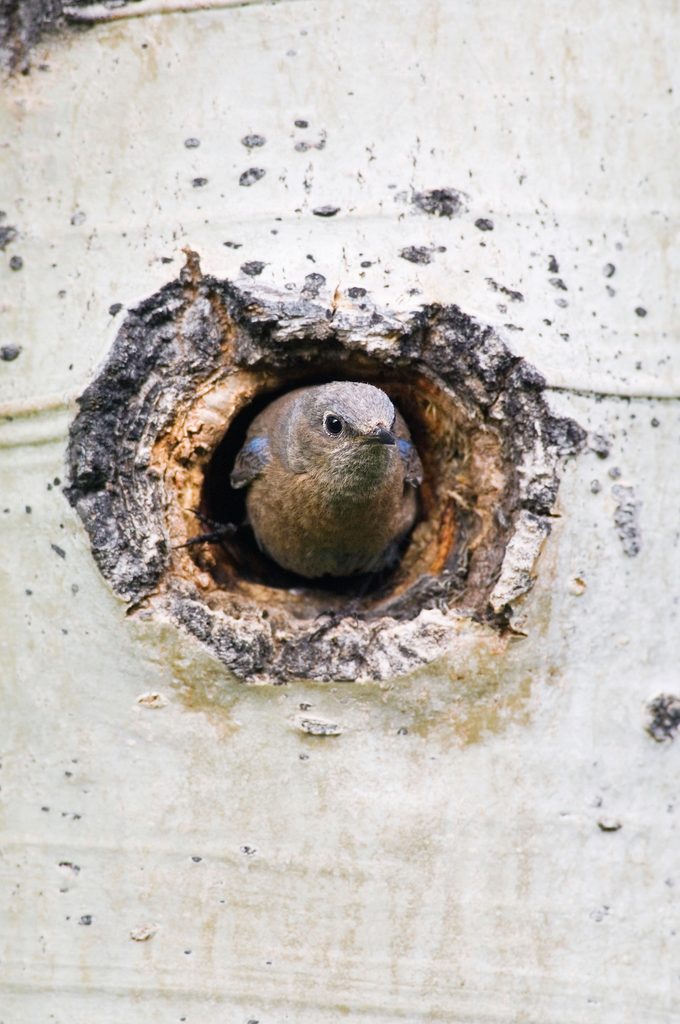
These bluebirds nest early, starting to look for a nest site in February or early March, but don’t actually lay eggs until April. Though western bluebirds are cavity nesters, they don’t make the holes for themselves. Instead, they use woodpecker holes and other existing hollows, often in dead trees.
According to Joyce, you can lure western bluebirds to your yard with nest boxes if the boxes are in a clearing near trees with a bird bath or creek close by. Westerns don’t prefer big open meadows or large bodies of water. A nest box should be constructed of rough wood that is 5 inches square by 8 inches deep with a 1½-inch hole. Place the box on a free-standing pole, at least 5 feet above the ground.
Here’s how to build a DIY bluebird house.
“Note where the wind mainly comes from, then face the hole in the opposite direction,” Joyce says. “If the wind is from the north, the hole should face south. They aren’t an urban bird, so the box needs to be in an outlying area.”
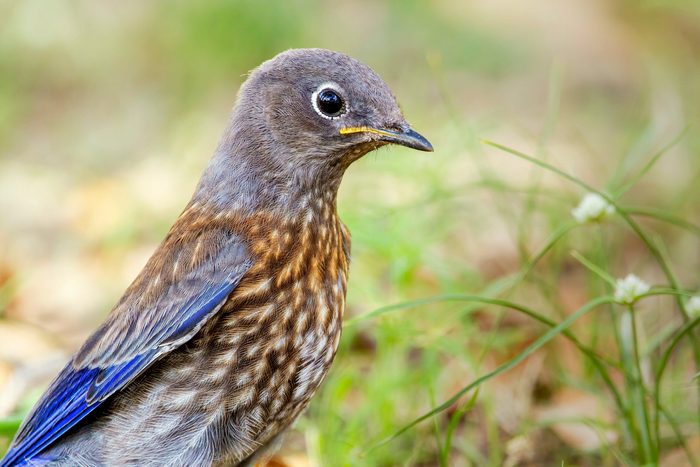
Western bluebirds may look like sweet blue songbirds, but they will ferociously defend their nests. For this reason, Joyce suggests putting up more than one box if possible, spacing them 100 to 200 feet apart. Then, westerns can peacefully raise their broods, one to three per year, next to their neighbors.
Most birds mate for a breeding season or nesting period, but that kind of monogamy is less appealing to western bluebirds. Researchers discovered that 45 percent of nests held young that were not fathered by the male who defended the nest, and 19 percent of all chicks were not the defending male’s.
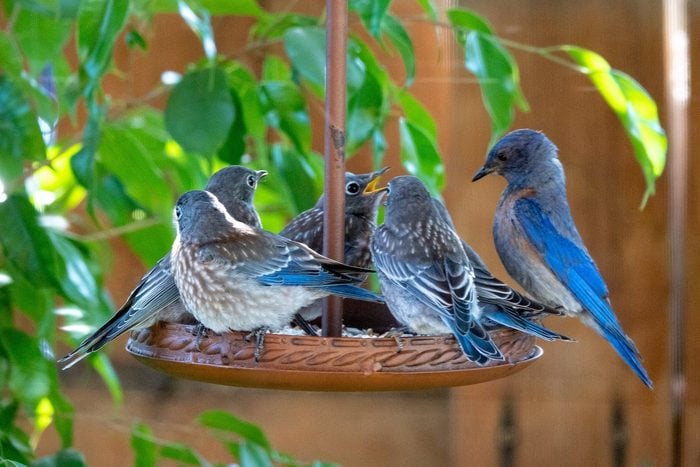
Some western bluebird parents get extra parenting support. These assistants, which help feed and protect the new hatchlings, are usually offspring from a previous brood.
Juvenile western bluebirds have spotted backs to match their marked bellies, and the blue tint of their wings and tails also helps ID them.
Learn how to keep house sparrows out of bluebird boxes.
Western Bluebird Song
Bird songs courtesy of the Cornell Lab of Ornithology
Western Bluebird Habitat and Range Map
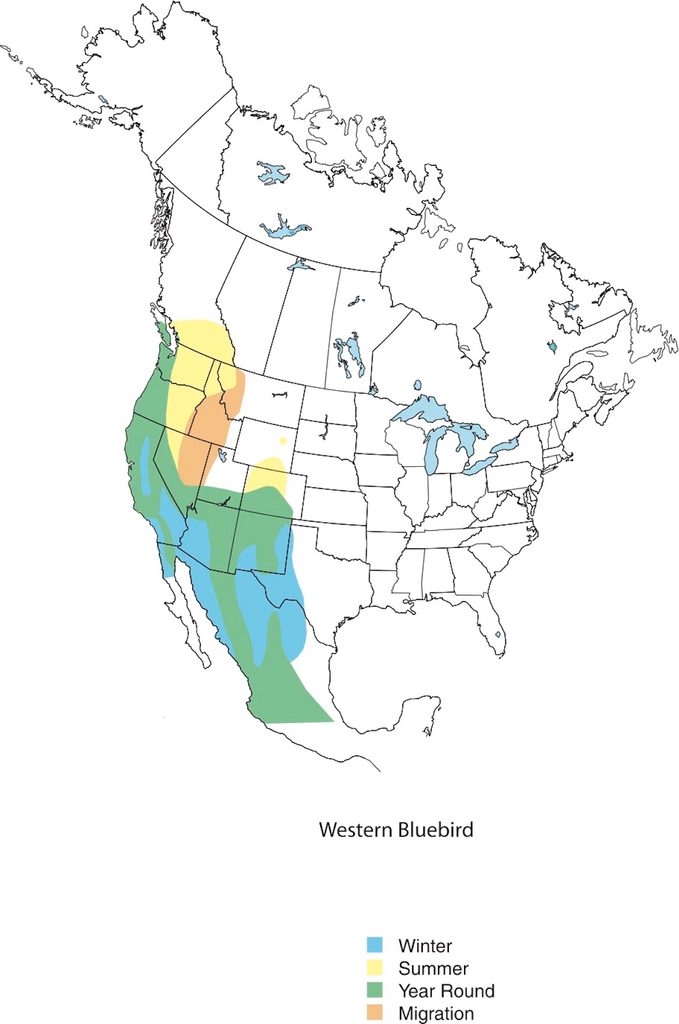
Range maps provided by Kaufman Field Guides, the official field guide of Birds & Blooms.
These small, vibrantly colored members of the thrush family are only partial or short-distance migrants. When they find a place they like, they’ll often stick around year after year.
This species breeds in the west. It replaces the eastern bluebird in areas west of the Great Plains. In the Southwest, it’s mostly a bird of foothills and mountains. Along the Pacific Coast, it lives in parks and yards. According to the Cornell Lab of Ornithology, western bluebirds are less commonly spotted in meadows than the other two bluebird species.
Western bluebirds spend winter in various kinds of open woods. They may gather in large flocks, especially in foothills with juniper berries; they also move out into desert areas.
About the Expert
Joyce Volmut is a Climate Watch Coordinator for Olympic Peninsula Audubon Society. Collecting data from participants in Audubon’s Climate Watch program, she plays a vital role in monitoring Audubon’s selected target bird populations—including western bluebirds.
Sources
- Cornell Lab of Ornithology, All About Birds: Western Bluebird
- National Audubon Society, Western Bluebird
- Montana Field Guide, Western Bluebird
- Audubon California, Western Bluebird Boxes
Why Trust Us?
For nearly 30 years, Birds & Blooms, a Trusted Media Brand, has been inspiring readers to have a lifelong love of birding, gardening and nature. We are the #1 bird and garden magazine in North America and a trusted online resource for over 15 million outdoor enthusiasts annually. Our library of thousands of informative articles and how-tos has been written by trusted journalists and fact-checked by bird and garden experts for accuracy. In addition to our staff of experienced gardeners and bird-watchers, we hire individuals who have years of education and hands-on experience with birding, bird feeding, gardening, butterflies, bugs and more. Learn more about Birds & Blooms, our field editor program, and our submission guidelines.
On This Page
Are Monarch Butterflies in Danger of Extinction?
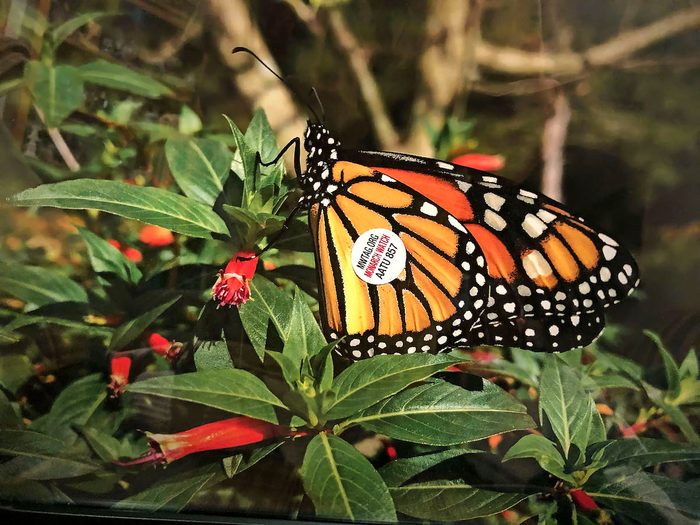
Monarchs are among the most recognizable and best loved butterflies in North America, but you might have noticed fewer of them traveling through your garden over the last few years. Given the less frequent sightings, you might’ve wondered: are monarch butterflies endangered?
The answer is both yes and no. Migratory monarch butterflies entered the International Union of Conservation of Nature‘s Red List of Threatened Species as endangered in 2021. However, in late 2023, the butterfly’s status was reassessed and listed instead as vulnerable. This change in terminology came not from an increase in monarch numbers, but from a shift in the data used to assign classifications.
Monarch Population Numbers Continue to Decline
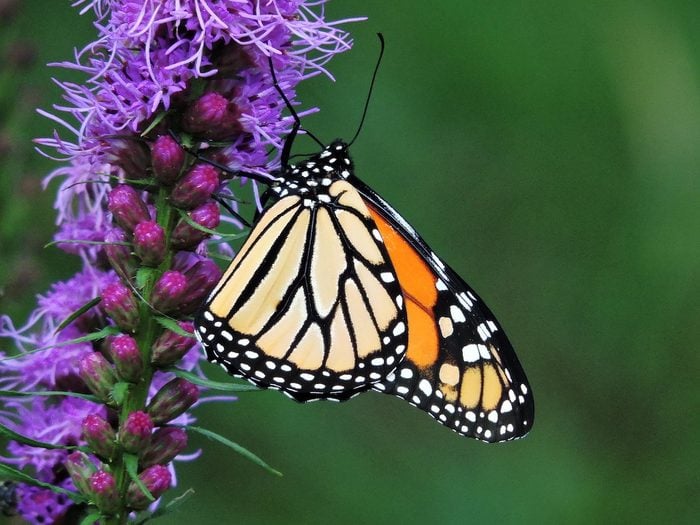
Researchers have split monarchs into two groups at the Rockies: eastern and western. They’re not distinct species, but their migration paths and overwintering habitats differ.
According to the IUCN, the western population is at greatest risk of extinction, having declined by an estimated 99.9%, from as many as 10 million to 1,914 butterflies between the 1980s and 2021.
The larger eastern population also shrunk by 84% from 1996 to 2014. During the 2023-2024 winter season, the eastern monarch population shrunk by 59%, occupying just 2.2 acres from the previous year’s 5.5 acres. According to a report released by World Wildlife Fund, the decreased numbers resulted from droughts in the United States and Mexico, as well as herbicide use.
“The severe drought conditions in the southern U.S. and Mexico suggested the population would likely decrease,” says Wendy Caldwell, Executive Program Director for Monarch Joint Venture. “We expected some kind of decline, but it was a pretty significant drop to the second-lowest population ever.”
Why Are Monarch Numbers Decreasing?
Why are monarch butterfly numbers in such steep decline? Mary Phillips, head of Garden for Wildlife from the National Wildlife Federation, says, “Monarchs are threatened with widespread habitat loss, increased use of pesticides to control insects and weeds, and natural enemies such as predators, parasitoids, and diseases. A changing climate is making some habitat less suitable and forcing changes in migratory patterns.”
Mary further explains that milkweed, the only host plant on which monarchs lay their eggs, used to grow abundantly across the United States. “The best way to help monarchs is restoring their natural habitat by planting native milkweeds and nectar plants, eliminating pesticides and encouraging others to adopt these practices,” she says.
Discover what monarch caterpillars look like, as well as three butterflies that look like monarchs.
Reasons for Monarch Optimism
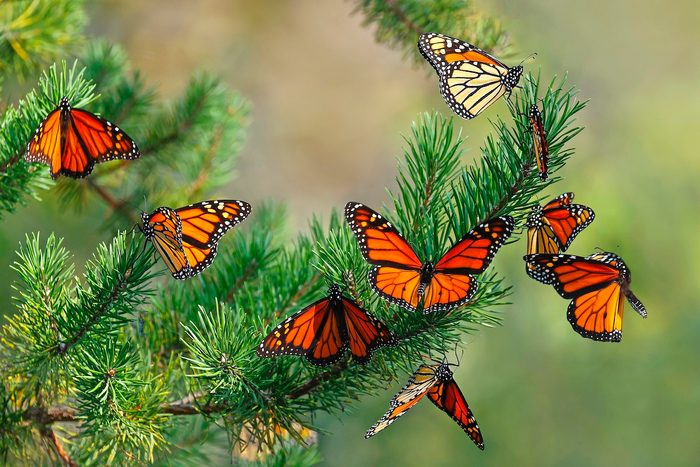
There is still reason to hope for West Coast monarchs. The Xerces Society and other organizations with similar goals are pushing to restore and protect overwintering, breeding and migration habitat throughout the West and into Mexico.
“It is difficult to watch monarch butterflies and their extraordinary migration teeter on the edge of collapse, but there are signs of hope. So many people and organizations have come together to try and protect this butterfly and its habitats. From planting native milkweed and reducing pesticide use to supporting the protection of overwintering sites and contributing to community science, we all have a role to play in making sure this iconic insect makes a full recovery,” said Anna Walker, member of the IUCN SSC Butterfly and Moth Specialist Group and Species Survival Officer at the New Mexico BioPark Society, who led the monarch butterfly assessment.
Do monarch butterfly sightings have meaning?
Grow a Garden for Monarch Butterflies
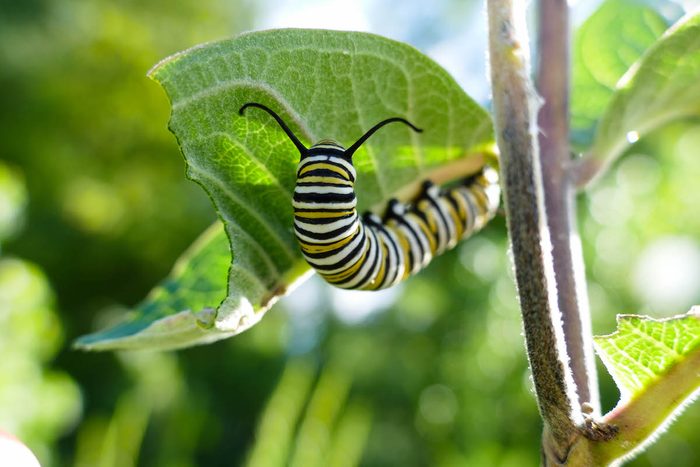
Weather plays a large part in conservation, but there’s plenty gardeners can do to help, too. Planting natives and choosing natural, non-insecticide or herbicide solutions for weeds and pests go a long way in sustaining the beloved monarch.
All monarchs start their lives on milkweed; it’s the only plant on which adults lay their eggs and caterpillars happily munch. Consider planting one of the many native varieties of milkweed in your pollinator garden to get an up-close view of the monarch life cycle. Avoid tropical milkweed, however. It’s a non-native plant, and it can negatively affect monarch migration patterns.
Support adult monarchs on their long journey south by growing nectar-rich flowers that bloom from late summer into fall. Try goldenrod, asters and coreopsis. “Adult monarchs feed on the nectar of many flowers, but they breed only where milkweeds are found,” Mary says.
More Ways to Help Monarchs
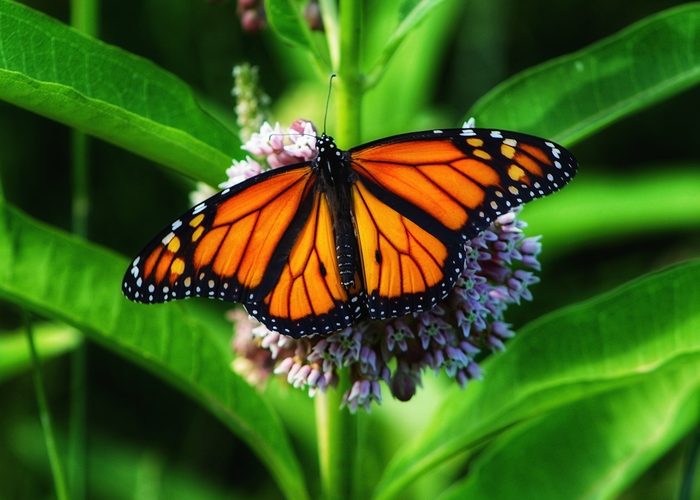
- Encourage local leaders to join the Mayors’ Monarch Pledge.
- Engage in community conservation actions such as native habitat restoration, education and outreach and local policy changes to benefit monarch butterflies.
- Enroll in monarch conservation, community-based science opportunities in local communities.
- Reduce or eliminate the use of pesticides.
- Create an outdoor space using native plants that attract monarchs and other pollinators. Once you’ve incorporated all the elements of a wildlife-friendly habitat—food, water, cover, and places to raise young—be recognized by certifying your space through Garden for Wildlife’s signature Certified Wildlife Habitat program. Every $20 application fee helps further protect and restore key habitat for pollinators and other wildlife. Every certified garden also counts toward meeting the goals of the Million Pollinator Garden Challenge.
- Butterfly Heroes is an initiative that connects gardeners and kids and families alike to help monarch butterflies and other pollinators. By taking a pledge to be a Butterfly Hero, pledgers are committing to create new habitat for monarchs.
- It is not imperative to report every monarch in your garden. However, many gardeners like to keep their own records and track how many monarchs they see from one year to another. For reporting, the Western Monarch Thanksgiving Count is the oldest and best. The Xerces Society has been cataloging the rapid decline of monarchs. It’s important to follow their guidelines and suggestions for the count.
Psst—if you’re interested in raising monarch butterflies, here’s what you need to know.
Additional reporting by Emily Hannemann
About the Experts
Wendy Caldwell is the executive director for Monarch Joint Venture. Having worked to conserve monarch populations for more than a decade, she has helped Monarch Joint Venture partner with nearly 100 organizations to help educate the public about monarchs and the importance of monarch conservation.
Mary Phillips is Head of Native Plant Habitat and Certifications for the World Wildlife Fund. As leader of WWF’s Garden for Wildlife programs, Mary advocates for gardeners to include native plants in their landscapes. She collaborates with conservationists, entomologists, federal agencies and more to make native plants accessible for all.
Anna Walker is the Species Survival Officer for Invertebrate Pollinators at New Mexico BioPark Society. Her work focuses on preserving threatened species of insects, including butterflies, bees, and butterflies.
Sources
- The Xerxes Society for Invertebrate Conservation
- International Union for Conservation of Nature
Why Trust Us
For nearly 30 years, Birds & Blooms, a Trusted Media Brand, has been inspiring readers to have a lifelong love of birding, gardening and nature. We are the #1 bird and garden magazine in North America and a trusted online resource for over 15 million outdoor enthusiasts annually. Our library of thousands of informative articles and how-tos has been written by trusted journalists and fact-checked by bird and garden experts for accuracy. In addition to our staff of experienced gardeners and bird-watchers, we hire individuals who have years of education and hands-on experience with birding, bird feeding, gardening, butterflies, bugs and more. Learn more about Birds & Blooms, our field editor program, and our submission guidelines.
On This Page
What Do Eurasian Collared-Doves Look Like?
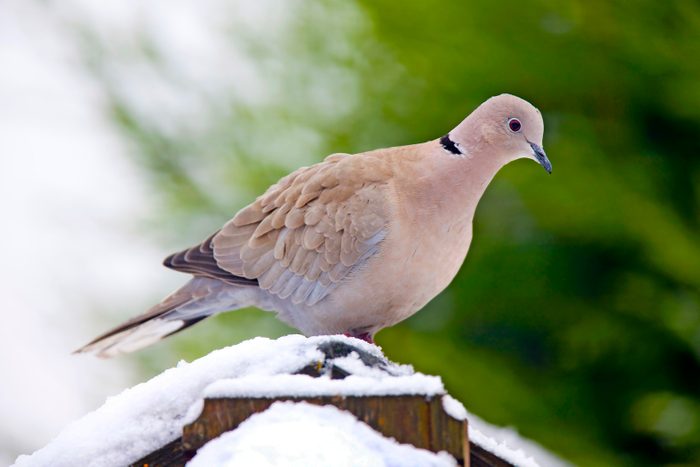
Eurasian collared-doves are sometimes confused with mourning doves. If a thick black band is present on the collar, it’s a collared dove. Although visually similar, Eurasian collared-doves are heftier than mourning doves and have greater wingspans—a difference of about 10 centimeters.
Range
“What’s the difference between the doves with plain gray feathers and the ones with a black ring around the neck?” asks Birds & Blooms reader Wil Bridger of Twin Falls, Idaho.
Birding experts Kenn and Kimberly Kaufman explain, “This reflects a fascinating change in North American bird life. Eurasian collared-doves, the ones with the black rings, are native to Europe and Asia. They escaped in the Bahamas in the 1970s and thrived in the wild there. In the 1980s, some strayed to Florida, where they established a population and began to increase in numbers.
Soon they expanded their range toward the west and north into areas where mourning doves, which are mostly gray, are common. Collared-doves are still scarce in the Northeast and upper Midwest, but they are now common all over the southern and western states. A few reached your area of Idaho around 2005, and they’ve been increasing ever since.”
Great Backyard Bird Count data shows the Eurasian collared-dove has now expanded its range to more than 39 states and into Canada.
There are four predominant dove species found in the Southwest: Eurasian collared-dove, Inca dove, mourning dove and white-winged dove.
Eurasian Collared-Dove Sound
The Eurasian collared-dove’s voice is a “coo-coo-coo” and they also emit a harsh “krreew” when in flight. Do mourning dove feathers and wings make noise?
Bird sounds courtesy of the Cornell Lab of Ornithology.
Diet
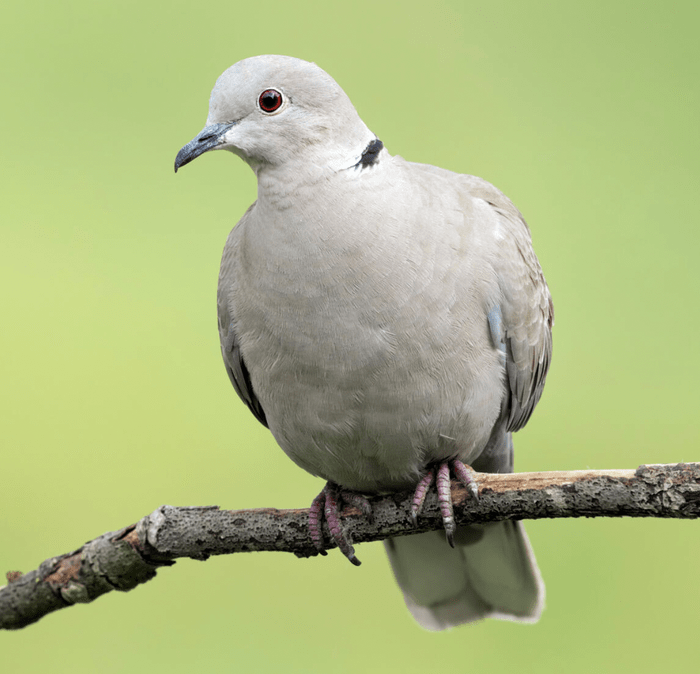
Eurasian collared-doves tend to make their homes in urban and suburban areas but stay away from large cities. They are not timid and are tolerant of humans. These doves will visit your bird feeder, mostly feeding on the seed that falls to the ground. They also eat insects as well, but grains are their favorite food.
Don’t miss 25 breathtaking mourning dove pictures.
Nesting Habits
In areas with mild winters, they breed year round and average three to four broods per year, laying two eggs at a time on a stick nest. The female incubates the eggs at night, while the male sits on them during the day. The male and female are very similar in appearance and difficult to tell apart from the other. They are almost always seen in pairs and mate for life.
Learn more about baby mourning doves and mourning dove nests.
Additional reporting by Kaitlin Stainbrook
About the Experts
Kenn and Kimberly Kaufman are the official birding experts for Birds & Blooms. They are the duo behind the Kaufman Field Guide series. They speak and lead bird trips all over the world.
Sources
- Cornell Lab of Ornithology – Eurasian Collared-Dove
- Great Backyard Bird Count
- Southern Wisconsin Bird Alliance
Why Trust Us
For nearly 30 years, Birds & Blooms, a Trusted Media Brand, has been inspiring readers to have a lifelong love of birding, gardening and nature. We are the #1 bird and garden magazine in North America and a trusted online resource for over 15 million outdoor enthusiasts annually. Our library of thousands of informative articles and how-tos has been written by trusted journalists and fact-checked by bird and garden experts for accuracy. In addition to our staff of experienced gardeners and bird-watchers, we hire individuals who have years of education and hands-on experience with birding, bird feeding, gardening, butterflies, bugs and more. Learn more about Birds & Blooms, our field editor program, and our submission guidelines.
Aphids on Milkweed
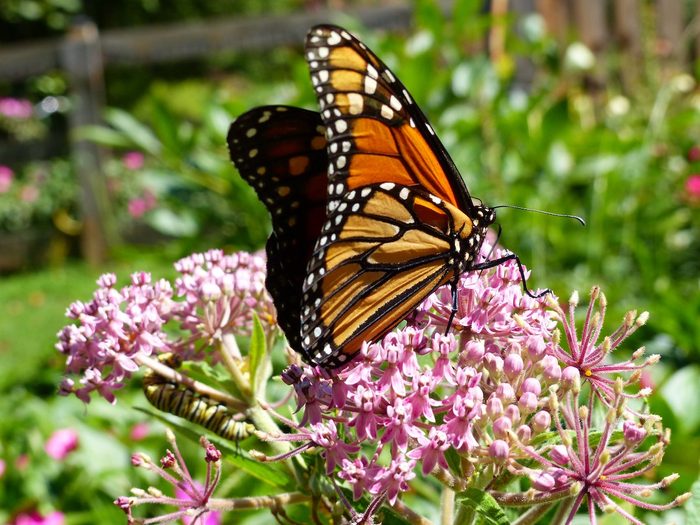
“My milkweed plants have curly leaves and deformed flowers. What went wrong?” says Susan Nowicki Woodridge, Illinois.
Horticultural expert Melinda Myers says, “Aphids are a common milkweed pest. They look like tiny yellow specks with black legs and are often found by the dozens clustered near the plant stem. Milkweed aphids suck plant juices and excrete the excess as a clear, sticky substance called honeydew. Their feeding can cause leaves to curl and, in some instances, distort the shape of the flowers.
A black fungus often grows on the honeydew as well. This does not directly harm the plant, but in severe cases it can prevent sunlight from reaching the leaves.”
Should gardeners remove milkweed bugs?
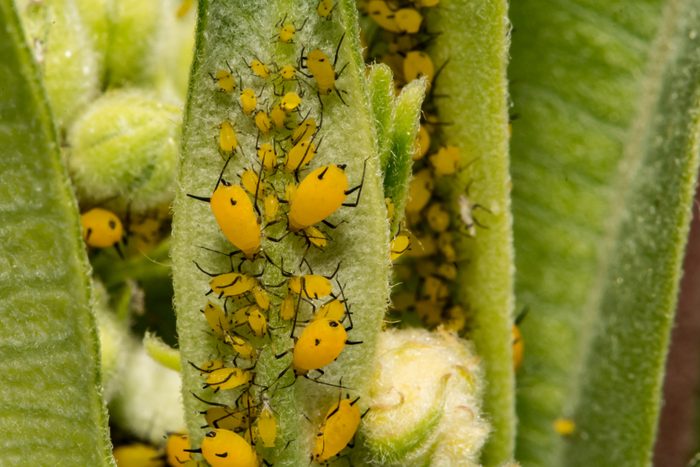
Sometimes patience is your best defense. Melinda explains, “Consider waiting for natural predators like lady beetles, parasitic wasps or green lacewings to move in and eat the pests. Lady beetles have an aphid eating reputation for good reason. Give nature a hand, if needed, by dislodging the aphids with a strong blast of water from the hose. Or you can pick them off by hand. Organic controls like insecticidal soap can be used, but they will harm any monarch eggs and caterpillars you are trying to support.”
Next, check out more natural ways to eliminate garden pests.
Aphids on Honeysuckle Vine
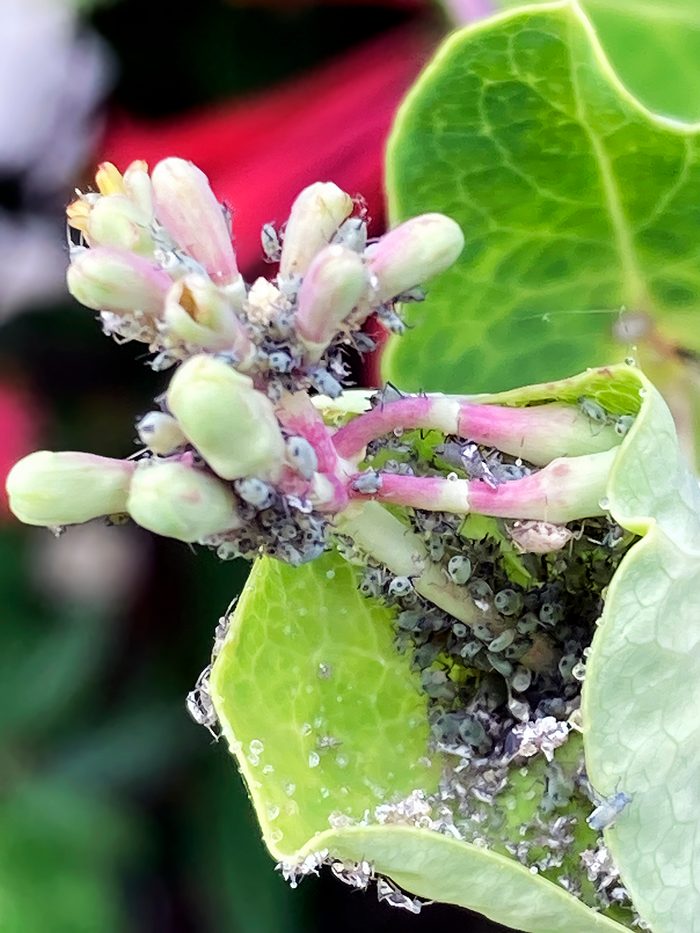
“My Major Wheeler honeysuckle vine got infested with these tiny gray bugs or eggs. What are they?” asks reader Susan Huffington of New Castle, Delaware.
Melinda says, “Aphid insects are feeding on your plant. They have a piercing, sucking mouthpart to stab leaves or stem surfaces and suck up plant sap. The aphids then secrete the excess as a clear sticky substance called honeydew. These insects are typically not a common problem for Major Wheeler honeysuckle vine, and the hummingbirds that nectar on the flowers of my plant also eat any aphids.
A strong blast of water will dislodge small populations of this pest. Pruning out and discarding areas with high populations is another way to minimize damage.
Organic insecticidal soap and lightweight horticulture oils will also control these pests. Because these are contact insecticides that must cover the insect to be effective, be careful not to accidentally spray any beneficial insects visiting the plant. Repeat applications may be needed, so always read and follow label directions.”
Why Trust Us
For nearly 30 years, Birds & Blooms, a Trusted Media Brand, has been inspiring readers to have a lifelong love of birding, gardening and nature. We are the #1 bird and garden magazine in North America and a trusted online resource for over 15 million outdoor enthusiasts annually. Our library of thousands of informative articles and how-tos has been written by trusted journalists and fact-checked by bird and garden experts for accuracy. In addition to our staff of experienced gardeners and bird-watchers, we hire individuals who have years of education and hands-on experience with birding, bird feeding, gardening, butterflies, bugs and more. Learn more about Birds & Blooms, our field editor program, and our submission guidelines.
On This Page
What Does a Sphinx Moth Look Like?
Some of my favorite moths to look for are sphinx moths, members of the family Sphingidae. These large moths are spectacular flyers, with streamlined bodies and wings evolved for speed and agility. A sphinx moth is one of only a few creatures capable of hovering in flight, like bats and hummingbirds, and is sometimes mistaken for the latter.
Like their close cousins, butterflies, sphinx moths feed using their proboscis, a coiled tube on the front of their heads that they uncurl and dip deep into flowers for nectar. A sphinx moth’s proboscis may be more than 11 inches long on some large tropical species. The wingspan of sphinx moths varies by species. Big poplars spread their wings 4 to 6 inches, while smaller sphinxes, like hummingbird clearwings, open to about 2 inches.
See what a sphinx moth caterpillar and pupa looks like.
Where and When to Find Sphinx Moths
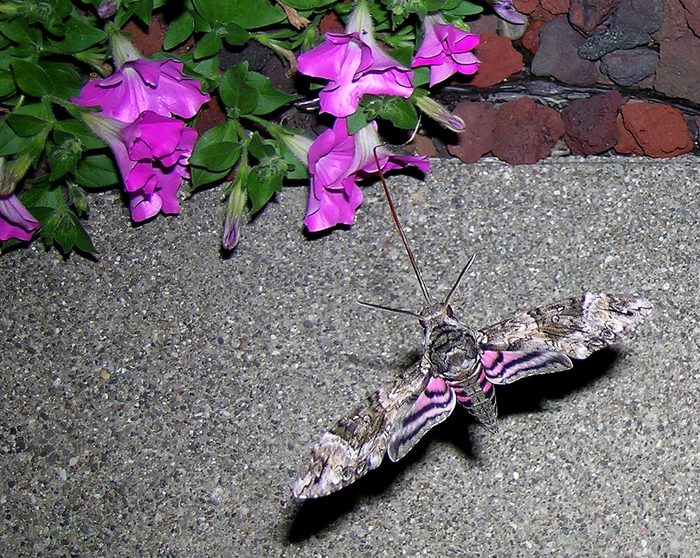
Some sphinx moths are diurnal, which means they fly during the day. Most fly at night, and a great time to look for them is during the evening after the sun sets but before it’s completely dark. They’re especially drawn to light-colored blooms in the garden. Attract sphinx moths by planting flowers that are their best in the evening and at night, like moonflowers or four-o-clocks. Some squash species are also night-blooming and are exclusively pollinated by moths.
Enjoy the backyard benefits of a moon garden.
Fascinating Facts About Sphinx Moths
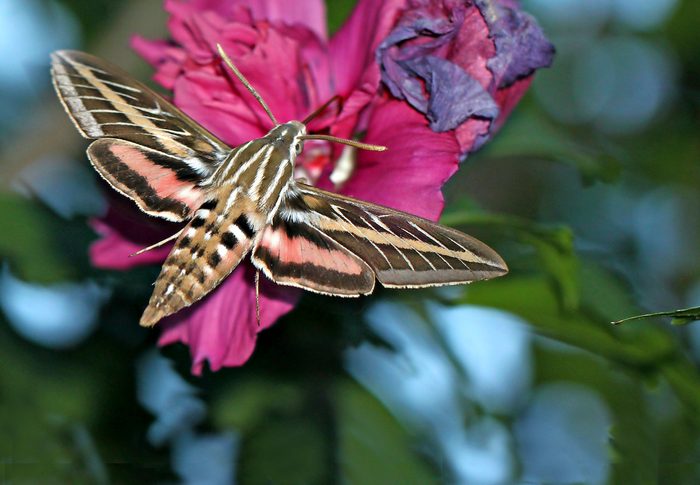
- The wingspan of sphinx moths varies by species. Big poplars spread their wings 4 to 6 inches, while smaller sphinxes, like hummingbird clearwings, open to about 2 inches.
- A sphinx moth’s proboscis (tongue that sips nectar) may be more than 11 inches long on some large tropical species.
- Of the four hummingbird moths in the sphinx family, only two of them are commonly seen—the hummingbird clearwing and the snowberry clearwing.
- Five-spotted hawk moth caterpillars, also known as tomato hornworms, are driven by voracious appetites to feast on tomato, tobacco and potato plants.
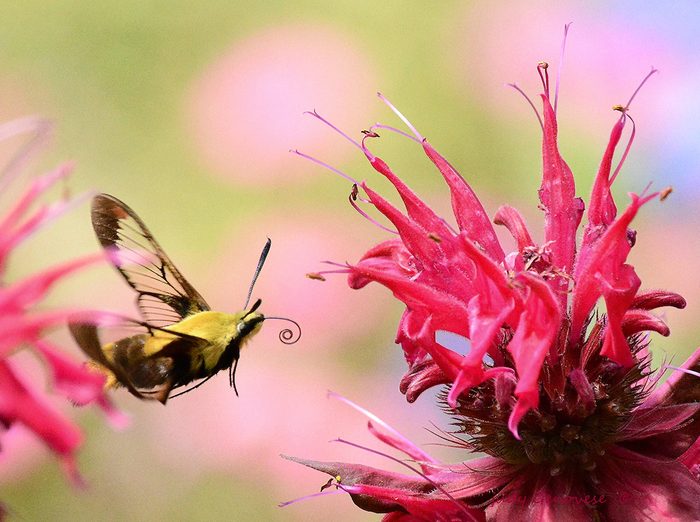
- Though not a bird (or a plane), sphinx moths move quickly. Snowberry clearwings have been clocked flying more than 30 mph.
- Just like the fliers they resemble, sphinx moths prefer nectar-filled, tube-shaped flowers. Try these four: daturas, columbines, four-o’clocks and flowering tobacco.
Types of Sphinx Moths to Know
There are hundreds of sphinx moths around the world. Here are some of the species you might find feeding on your flowers.
Rustic Sphinx Moth
That bold, beautiful pattern of black, white and gray is characteristic of the rustic sphinx moth (above). The large size and streamlined shape mark this as a member of the sphinx moth family. This is mainly a southern species, rarely wandering as far north as Canada. Fast-flying adults are active mostly at night, resting in the daytime. Caterpillars feed on the leaves of several plants, including bignonia, jasmine and Cape honeysuckle.
Moth vs butterfly: Here’s how to tell the difference.
Abbott’s Sphinx Moth
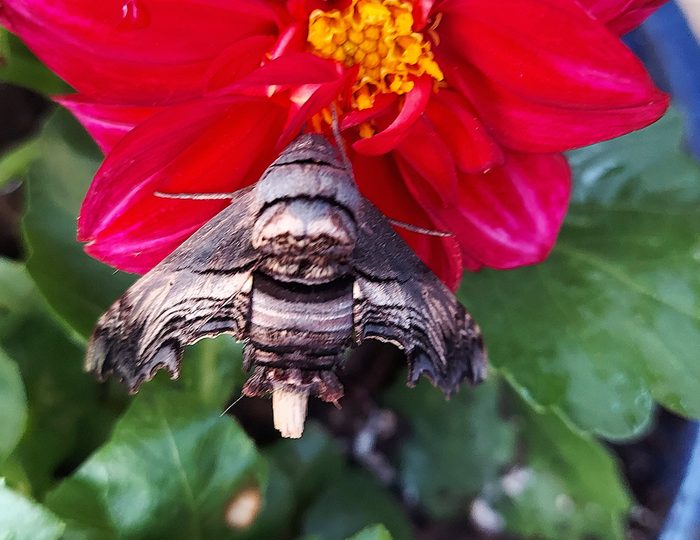
Official Birds & Blooms experts Kenn and Kimberly Kaufman write, “One of the smaller members of the sphinx moth family, is the Abbott’s sphinx (Sphecodina abbottii). The species is widespread in eastern North America, and its larvae usually feed on the leaves of wild grape plants (Vitis spp.). The adult moths often visit flowers at dusk, and sometimes earlier in the day. They make a soft buzzing sound in flight, unlike most sphinx moths, and they may have some natural protection from predators because of their slight resemblance to large bees.”
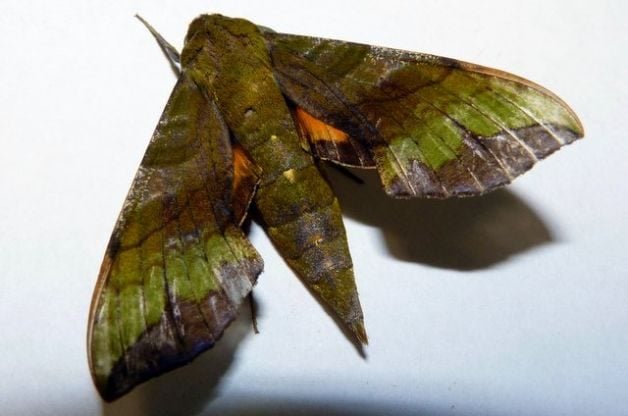
Pluto Sphinx Moth
Pluto sphinx moths (shown above) are olive green, but their hindwings show a flash of orange when they fly. This species is mainly confined to Florida and Texas, but the even showier pandora sphinx moth looks similar and is found throughout the eastern U.S.
These pictures will change the way you look at moths.
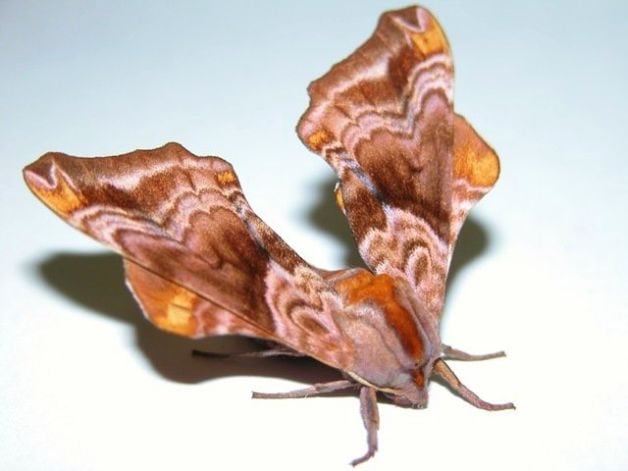
Small-Eyed Sphinx Moth
The small-eyed sphinx moth (above) is more common in the eastern half of the U.S., but can be found all the way west to California. Like many sphinx moths, the small-eyed sphinx flies at dusk, but also continues to fly all night long.
Discover 5 silk moths that might be in your backyard.
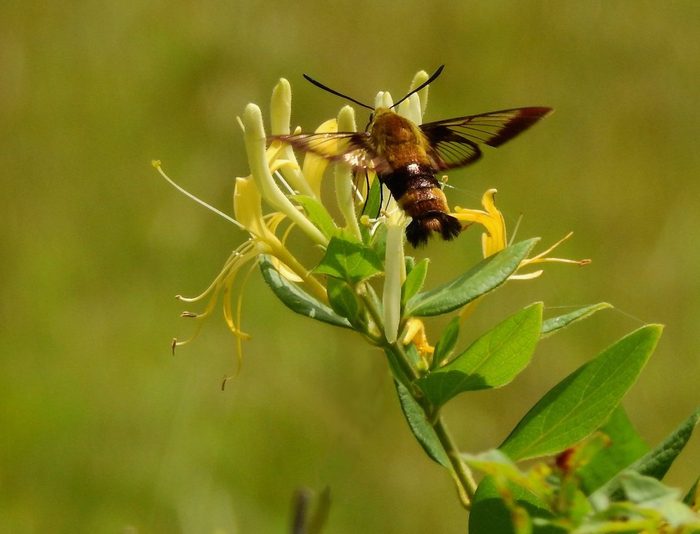
Hummingbird Clearwing Moth
The hummingbird clearwing or hummingbird sphinx moth (above) is active during the day, so many people are familiar with it. This is one of the diurnal (day-flying) moths, and frequently fools people into thinking it’s an actual hummingbird. Once you get a close look, though, you’ll see the proboscis and antennae up front and realize you’re actually looking at one of the most famous sphinx moths. Hummingbird clearwings are found throughout the eastern half of the U.S. and Canada. Attract them with the same flowers you’d use to attract butterflies. Though not a bird (or a plane), sphinx moths move quickly. Snowberry clearwings have been clocked flying more than 30 mph.
Check out interesting facts about hummingbird moths.
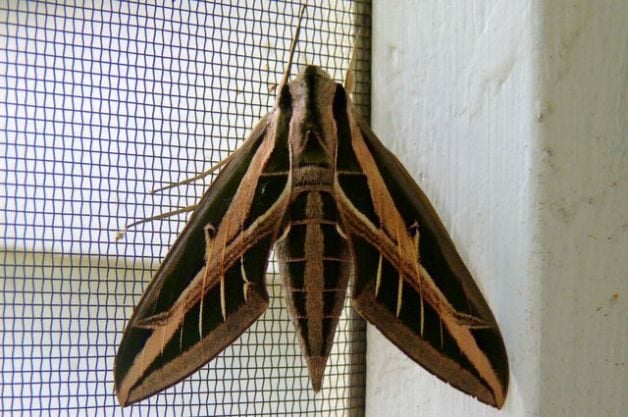
Banded Sphinx Moth
The banded sphinx moth (above) is primarily found in the southeast, but sometimes strays far to the north. This moth feeds from flowers once the sun goes down, but can often be observed at dusk without waiting for full-on dark. Its caterpillars feed on plants in the evening primrose family, so planting those is one way to attract these sphinx moths.
Meet the colorful moths you can see during daytime.
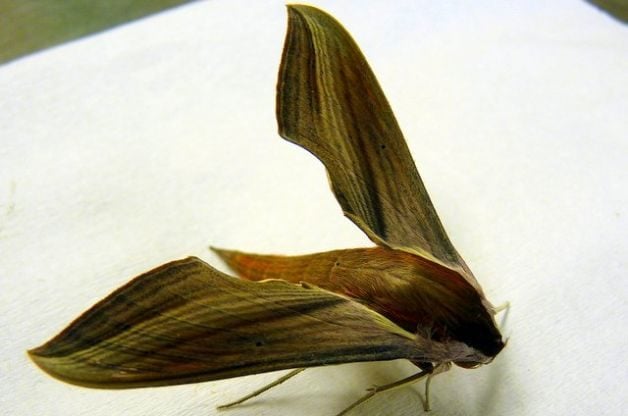
Tersa Sphinx Moth
This beautiful and streamlined creature is a tersa sphinx moth (above). It is sometimes called the “wooden moth”, and it does indeed look as though it’s been carved from wood. Adults may be sluggish in the daytime, but they fly around rapidly at dusk and night. When tersa sphinx moths visit gardens, they hover in front of flowers to feed, just as hummingbirds do. Caterpillars of this species feed on plants in the madder family, including pentas. Although tersa sphinx moths sometimes wander as far north as Canada, they mainly live in the tropics and in the southeastern states, from Texas to Florida and into North and South Carolina.
Learn all about garden moths: important pollinators.
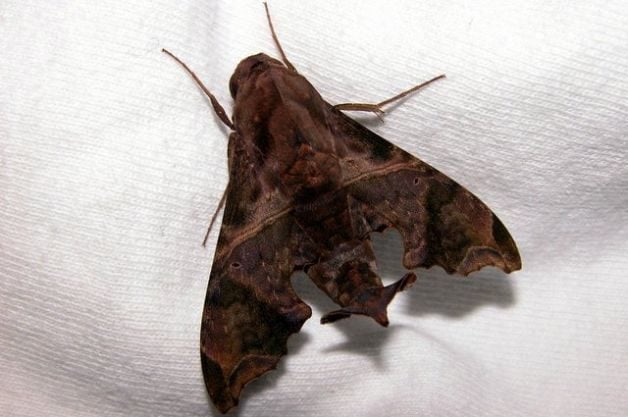
Mournful Sphinx Moth
Another moth mainly found in the southeast U.S., the mournful sphinx (above) is very dark brown in color and generally flies during the day. It’s known to make a surprisingly loud “whirring” sound from its wings.
Here’s what gardeners should know about the cabbage white butterfly.
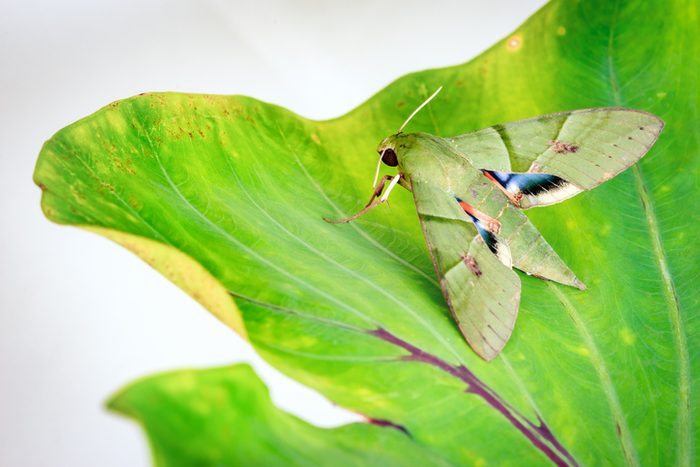
Gaudy Sphinx Moth
A gaudy sphinx moth (above) looks like a green leaf until you notice the amazing coloration on its lower wings. These green sphinx moths have a wingspan of up to 4 inches and are active at night, feeding from nectar flowers.
Learn how to identify a luna moth.
White-Lined Sphinx Moth
Yes, this is another one of the hummingbird moths, also known as hawk moths. Many of them take nectar by hovering in front of flowers, very much like a hummingbird. Some species are active only at night, but this one, the white-lined sphinx (above), will visit flowers in daylight. Its caterpillars feed on the leaves of a wide variety of host plants. It’s recognized by its striped and checkered body, white lines on the forewings, and broad pink stripe on the hindwings.
Plant a caterpillar cafe in your butterfly garden.
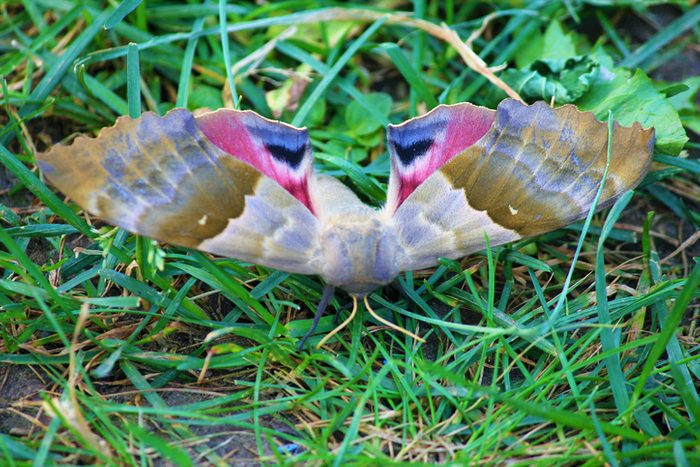
Big Poplar Sphinx Moth
The big poplar sphinx (above), with wings 4 to nearly 6 inches across, has no proboscis at all! It never feeds in its adult stage but emerges only to locate a mate and start the next generation.
Meet the milkweed tussock moth and caterpillar.
Pink-Spotted Hawkmoth
The pink-spotted hawkmoth (above) is another member of the sphinx or hummingbird moth family. This species is very widespread in the American tropics. In the United States, it is found most regularly in the southernmost states, but a few wanderers reach as far as Canada. Its larvae feed on the leaves of sweet potato, jimsonweed, morning glory and other plants. This moth is uncommon, so it’s always exciting to see one.
Here’s where you can spot a giant leopard moth.
Nectar Plants to Attract Sphinx Moths
Sphinx moths prefer nectar-filled, tube-shaped flowers.
- Brugmansia
- Butterfly bush
- Columbine
- Datura
- Evening primrose
- Flowering tobacco (Nicotiana)
- Four-o’clocks
- Honeysuckle
- Hosta
- Moonflower vine (Ipomoea alba)
- Nasturtium
- Verbena
Host Plants for Sphinx Moths
- Grapevine
- Honeysuckle
- Poplar (Populus species, including cottonwood, poplar, aspen)
- Snowberry (Symphoricarpos species)
- Virginia creeper
- Tomato
Next, learn fascinating facts about cecropia moths.
Why Trust Us
For nearly 30 years, Birds & Blooms, a Trusted Media Brand, has been inspiring readers to have a lifelong love of birding, gardening and nature. We are the #1 bird and garden magazine in North America and a trusted online resource for over 15 million outdoor enthusiasts annually. Our library of thousands of informative articles and how-tos has been written by trusted journalists and fact-checked by bird and garden experts for accuracy. In addition to our staff of experienced gardeners and bird-watchers, we hire individuals who have years of education and hands-on experience with birding, bird feeding, gardening, butterflies, bugs and more. Learn more about Birds & Blooms, our field editor program, and our submission guidelines.
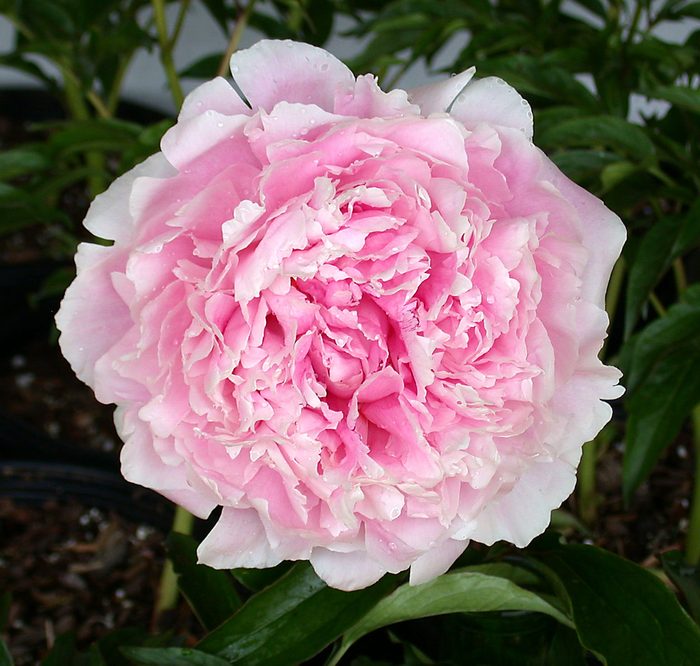
In spring you found yourself wandering the aisles of your favorite nursery in hopes of replacing that sickly rosebush you pulled from the garden late last fall. That’s when you saw it: a robust beauty with emerald-green foliage and a bounty of bright pink blooms. It’s picture-perfect. Fast-forward to a beautiful summer day a few months later. You’re weeding the garden. And that’s when you see them: black spots covering your once-perfect rosebush. Oh, no, not again! To make sure this doesn’t happen to you, choose disease-resistant plants.
On This Page
Disease-Resistant Plants Save Money
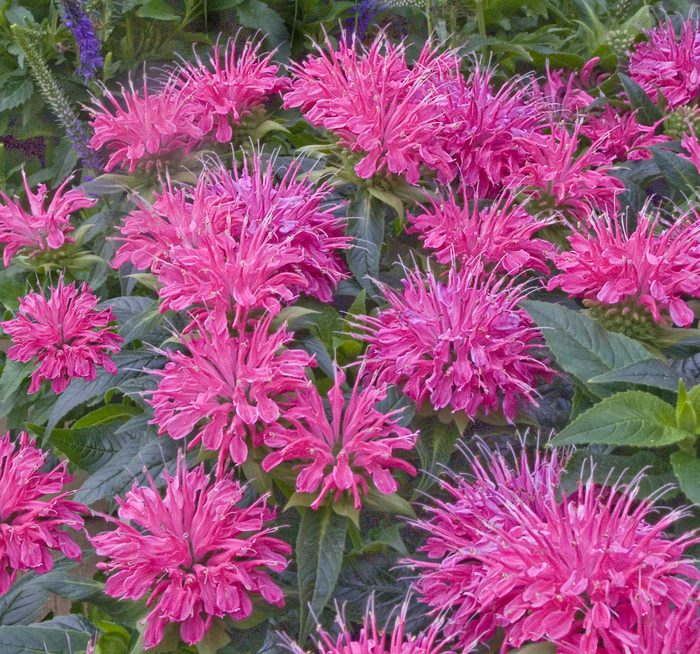
Now, if you’d planted a Knock Out rose instead, you probably wouldn’t be in this predicament. Why those? Because those cultivars are disease-resistant, friend. That means no baby-sitting and no black spots.
Selecting disease-resistant plants is undoubtedly one of the smartest things you can do when planning or freshening up your garden. Janna Beckerman, a professor of plant pathology at Purdue University, explains why.
“Plants are selected for a variety of reasons,” Janna says. “Unique flower color, floriferousness and the ability to rebloom are the most obvious. Yet another important but often overlooked trait is disease resistance. A disease-resistant plant is naturally less susceptible to pesky diseases and fungi like leaf spot, blight, gray mold, powdery mildew and rust. These plants are an investment that pays for itself. It also allows you to minimize your use of pesticides.”
So what plants tend to be the most vulnerable to disease? “Crabapple, roses, azalea, boxwood, hollyhock, peony, phlox, bee balm, annual and perennial geranium, impatiens, begonia—I could keeping going,” Janna says.
New Varieties Are Bred to Be Fighters
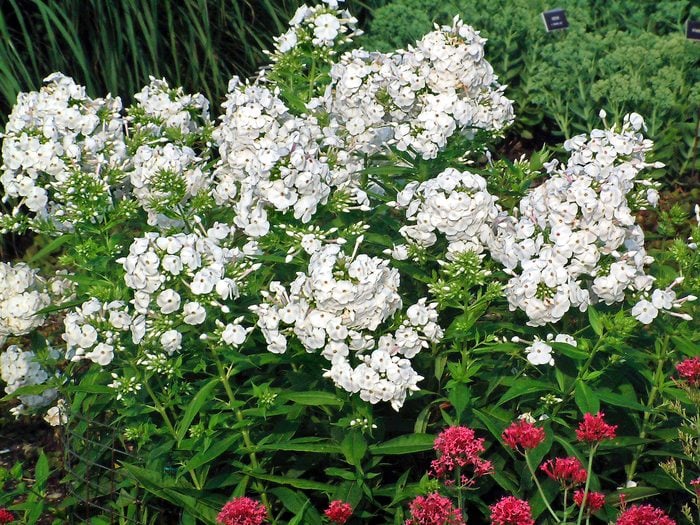
Plant breeders cultivate new disease-resistant offerings by selecting and crossbreeding plants with the traits they’re looking for. Breeding a modest parent plant that is genetically more resistant to disease with a vivacious partner that is known for its big blooms or gorgeous color creates a new variety that boasts the best of both worlds.
Luckily for us gardeners, disease-resistant plants aren’t hard to find. Many growers now market them this way, just as they do plants that attract wildlife or tolerate drought. If you still can’t find what you’re looking for, consider joining one of the many online garden forums on the subject, or check with the experts at your local extension office.
A few of Janna’s personal favorites that work especially well in her neck of the woods (and should thrive throughout the Midwest and Northeast) include Adirondack crabapple, Jacob Cline bee balm, David phlox and both the Pavement and Canadian Explorer series of roses.
Location and Climate Matters
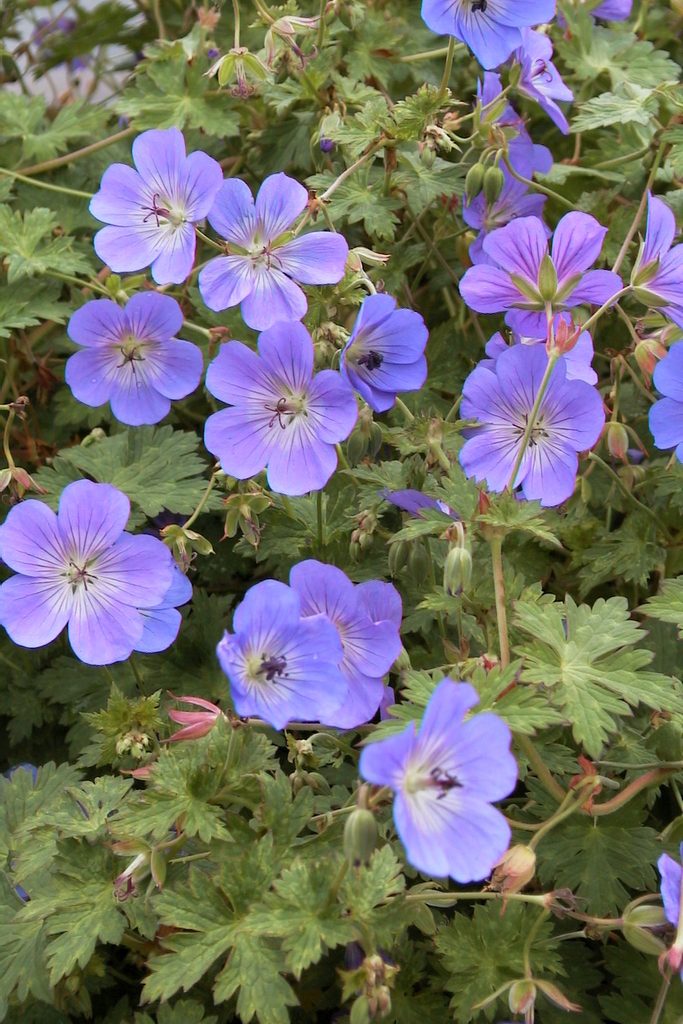
Just as getting enough sleep and exercise help keep human bodies healthy to fight off disease, so do good gardening habits work to keep your plants strong and resilient. The truth is that no plant is 100 percent immune to all disease.
“Sometimes a variety that is resistant in one part of the country could succumb to disease in another area, where the disease pressure is worse because the climate is wetter or warmer,” Janna says. “Also, evolution takes place in the garden, just as it does in the outside world, and pathogens can evolve to attack plants that previous generations of disease strains could not.”
Janna also notes that geography can mean a lot. For instance, when she goes to California, she notices that the roses have rust problems not common in the Midwest—though Californians don’t have to battle black spot as much.
Check out the most common plant problems and how to solve them.
Healthy Plant Dos and Don’ts
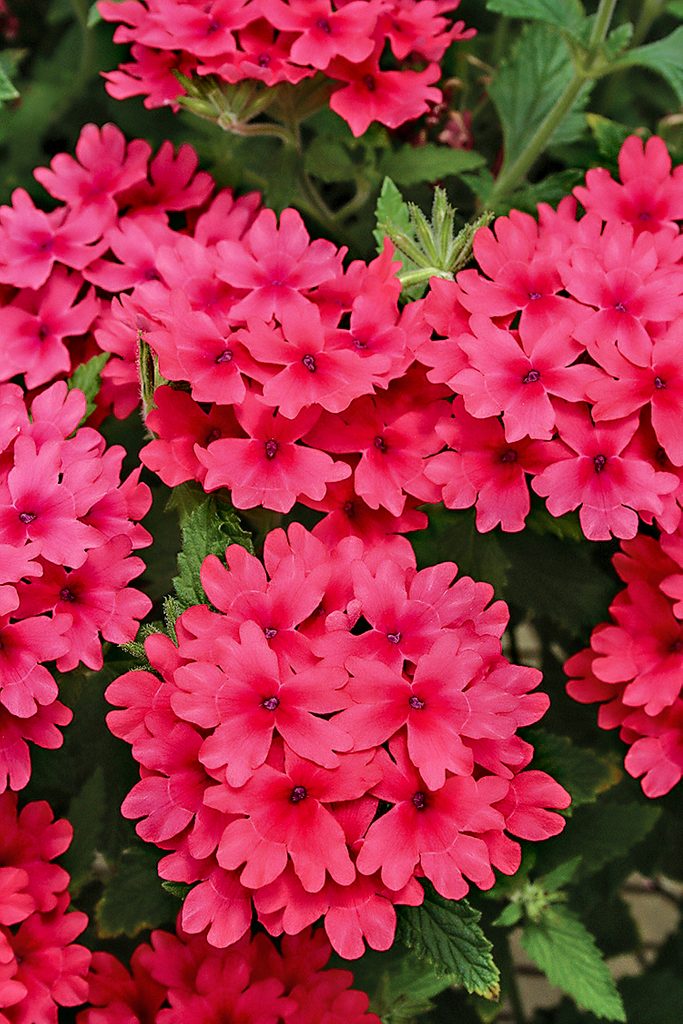
Now that you know the benefits of disease-resistant plants, there are a few final things to consider before digging in to your flower bed. By following these tips, you’ll be well on your way to a disease-free garden.
- DO select plants that thrive in your zone. Otherwise, stressful conditions weaken their performance and make them more susceptible to problems.
- DO plant the right plant in the right site, according to its light requirements.
- DON’T crowd your plants, and DO maintain good weed control. Good airflow is critical.
- DO pay attention to the plant’s water requirements. Growing bee balm in a dry site makes it susceptible to powdery mildew, while growing iris in a wet area predisposes it to root rot.
- DO water in the morning when the foliage has all day to dry, and DON’T water overhead, which can splash soil—where nasty stuff lurks—onto the foliage.
- DON’T overfertilize. People view fertilizer like vitamins—something that keeps living things healthy. But too much can be a bad thing, which can actually make plants more susceptible to disease.
Learn how to manage aster yellows disease and other coneflower problems.
Best Disease-Resistant Plants to Grow
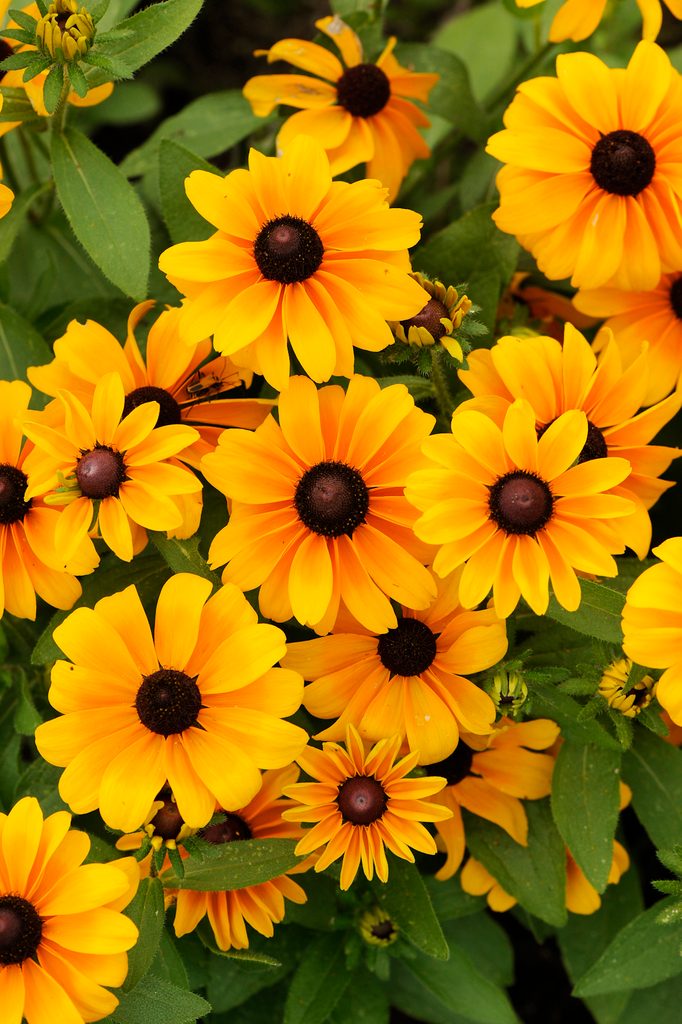
- New England Aster – Harrington’s Pink, Honeysong Pink, Purple Dome
- Azalea – Darlin’s Dream, Flame Creeper, Sautee Sunset
- Bee Balm – Jacob Cline, Pardon-My-Pink, Gardenview Scarlet
- Begonia – Duarten, Marion Louise, Pauline, Peace, Vesuvius
- Perennial Geranium – Alan Bloom, Buxton’s Blue, Biokovo, Rozanne
- Impatiens – Beacon, New Guinea
- Peony – America, Sarah Bernhardt, Scarlet O’Hara
- Garden Phlox – David, Laura, Robert Poore
- Rose – Blaze of Glory, Golden Showers, Heart Song, Knock Out, Olympiad, New Dawn
- Rudbeckia – Cherry Brandy, Tiger Eye Gold
- Speedwell – Icicle, Crater Lake Blue, Sightseeing
- Verbena – Aztec Dark Red, Coral, Empress Strawberry, Rapunzel Lilac
About the Expert
Janna Beckerman is a professor plant pathology in the department of biology at Purdue University. Research in her lab has focused on the biology and management of apple diseases, as well as improving fungicide efficacy in horticultural crops.
Why Trust Us
For nearly 30 years, Birds & Blooms, a Trusted Media Brand, has been inspiring readers to have a lifelong love of birding, gardening and nature. We are the #1 bird and garden magazine in North America and a trusted online resource for over 15 million outdoor enthusiasts annually. Our library of thousands of informative articles and how-tos has been written by trusted journalists and fact-checked by bird and garden experts for accuracy. In addition to our staff of experienced gardeners and bird-watchers, we hire individuals who have years of education and hands-on experience with birding, bird feeding, gardening, butterflies, bugs and more. Learn more about Birds & Blooms, our field editor program, and our submission guidelines.

Being a houseplant parent has increased in popularity in recent years. According to civicscience.com, 66% percent of consumers in the U.S. own at least one houseplant. With so many people growing houseplants, there are always learnings and our readers shared their best plant hacks for indoor gardening.
On This Page
Use Ice Cubes to Water Houseplants
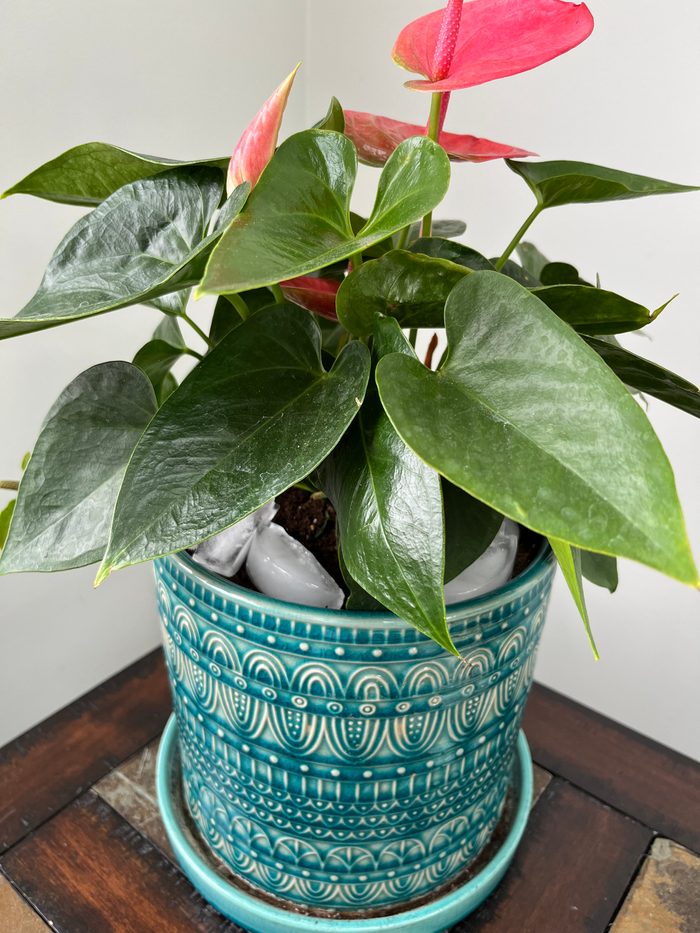
Proper watering is an essential step in knowing how to grow indoor plants. To help prevent a watery mess on the floor, one Birds & Blooms reader has a secret plant hack. “I put ice cubes in my hanging plants,” Roslyn Francis of Lodi, California, says. “As the ice melts, the soil absorbs the water and it doesn’t drip out the bottom of the pot.”
Reader Lisa Sherman of Carlsbad, California, also supports this watering method. “When my inside potted plants are dry, I put ice cubes on top of the soil to slowly melt and water the plant without flooding the pot,” she says. “It’s easy, there’s no mess, and I’m less likely to overwater this way.”
When is the best time to water plants?
Get Creative with Plant Placement
Some plants need full sun, some like full shade and some like a little of both. One hack that will give all of your plants what they need is to use furniture, such as long sofa tables and creatively place them in front of windows.
Reader Hope Cate of Wilmington, North Carolina explains. “I placed a long sofa table so that half of it is in front of a south-facing window,” she says. “Plants that prefer a lot of light are in the area in front of the window. But because the other half of the table is in the shade, I can have many plants in one spot, and they are all happy.”
These are the best houseplants for low light.
Find a Second Use for Your Coffee Grounds
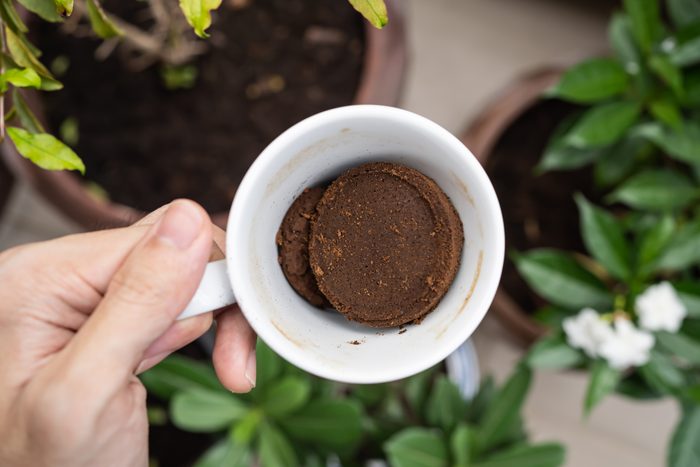
After the grounds from your daily cup of Joe have cooled, don’t toss them in the garbage. Reader Dolores Koland of Pelican Rapids, Minnesota, says, “Add coffee grounds to your houseplants and watch them thrive.”
Here are some ways you can use baking soda in your garden and landscape.
Invest in a Moisture Meter
Sometimes it’s tricky to gauge when a plant needs moisture. Instead of using your finger to gauge the moisture levels of your houseplants’ soil or just guessing that it’s time to water, you can use a moisture meter. Reader Tracy McCullum of Joliet, Illinois, says, “Use a soil moisture meter to prevent overwatering. It lets you know if the soil is wet, moist or dry.”
Can you reuse potting soil in planters?
Rotate Your Plants for Even Sun Exposure
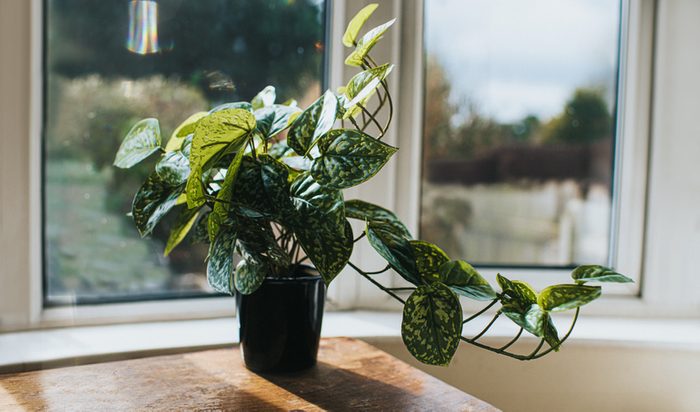
If you’ve noticed that your houseplants are leaning toward the light, try this super simple hack. To help maintain a symmetrical shape, rotate houseplants occasionally, maybe even every time you water if it helps you to remember.
Reader Judy Roberts of Graytown, Ohio, says, “Give the plants a quarter-turn once a week to even out their exposure to the sun. This will help your plant grow evenly.”
These 10 houseplants are best for beginners.
Give Plants Some Rainwater
Nothing beats a little fresh air and fresh water—and that’s true for your houseplants too. “If your pots are small enough to carry, put them out in a light rain when the weather is warm,” says reader Robbin Moller of Sylvania, Ohio. “I have yet to encounter a houseplant that doesn’t perk up with a little rain.”
Reader Sharon Woodworth of Georgetown, Kentucky, agrees. “Collect rainwater and use it on your houseplants. I’ve been doing it for years!” she says.
Before you buy your next houseplant, make sure it’s not on our list of houseplants you’ll regret.
Use The “10-10-10” Fertilizer Rule
Most houseplants do fine with a balanced fertilizer (10-10-10). Limit or stop fertilizing your indoor houseplants in winter and start feeding them again in spring. As always, follow the directions on your specific package.
Here’s why your indoor plant has yellow leaves.
Choose Small Houseplants for Small Spaces
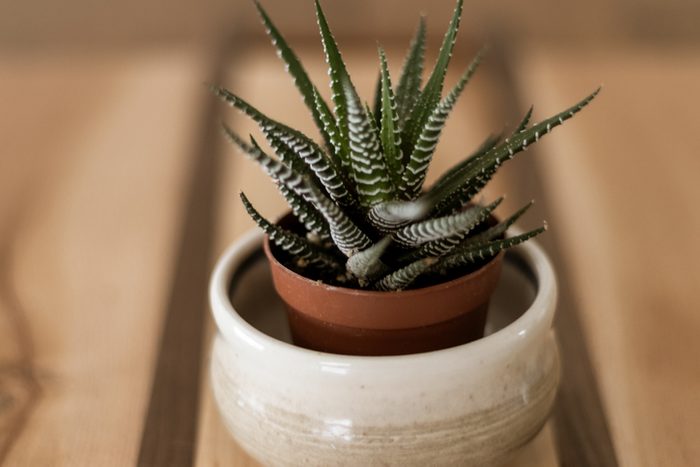
If you’re tight on space, most 3-inch pots fit on even the narrowest window sills. Peperomia and small cactuses and succulents can both happily grow in containers that size.
Use Artificial Grow Lights Right
When using artificial lights, the tips of the plants should be 6 to 12 inches from the light source to ensure the plant is receiving maximum benefits.
Boost Humidity for Tropical Plants
Ideal humidity for tropical houseplants is around 50%. If your home is drier, set your indoor plants on a gravel tray filled with water.
Kick Mildew to the Curb
“I read that sprinkling the dirt with cinnamon prevents powdery mildew, so I gave it a shot—it worked!” says reader Jeanine Buettner of Kalispell, Montana. She adds, “I no longer have a problem with the disease!”
Provide Extra Nutrients With Eggs
Reader Sandy Lewis of Akron, Ohio, waters her houseplants with water she has boiled eggs in. She says this one of our plant hacks, “works better for me than any commercial plant food!”
Next, discover more ways to use eggshells in the garden.
Additional reporting by Eva Monheim
Sources
- Birding and Gardening Secrets book, Birds & Blooms, 2011
- Civicscience.com
- University of Georgia Extension
- Portland Nursery
- University of Maryland Extension
- University of Florida Extension
- Iowa State University Extension
- University of Illinois Extension
Why Trust Us
For nearly 30 years, Birds & Blooms, a Trusted Media Brand, has been inspiring readers to have a lifelong love of birding, gardening and nature. We are the #1 bird and garden magazine in North America and a trusted online resource for over 15 million outdoor enthusiasts annually. Our library of thousands of informative articles and how-tos has been written by trusted journalists and fact-checked by bird and garden experts for accuracy. In addition to our staff of experienced gardeners and bird-watchers, we hire individuals who have years of education and hands-on experience with birding, bird feeding, gardening, butterflies, bugs and more. Learn more about Birds & Blooms, our field editor program, and our submission guidelines.
